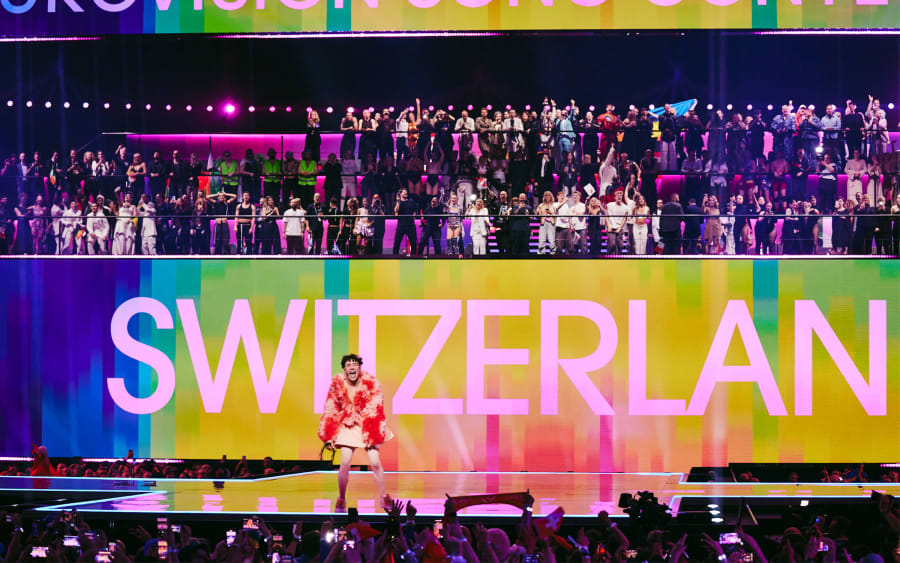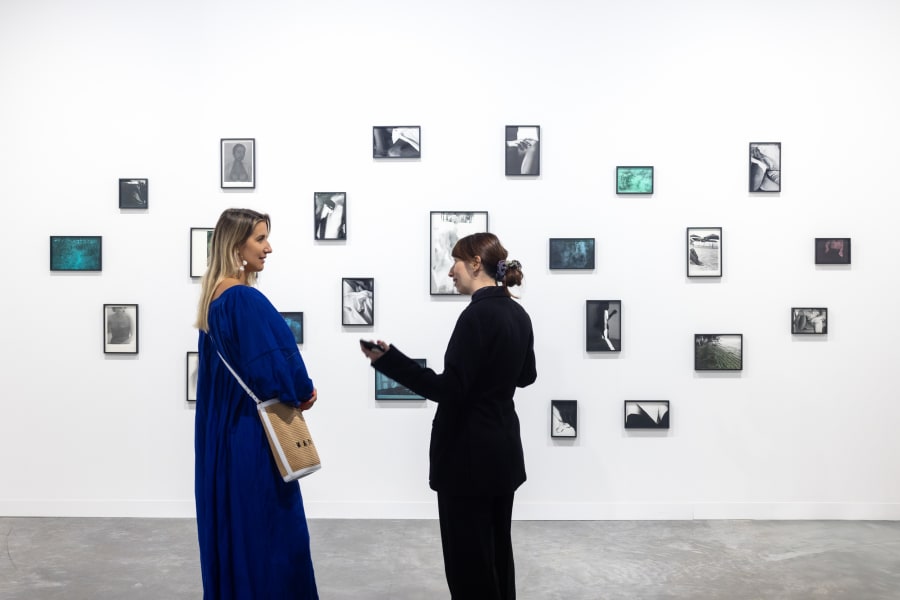The human body looms large in presentations by emerging artists at this year’s Art Basel: Is the body primarily a physical organism or a repository for personal and historical memory? Can a body be a site of oppression and resistance? What does it mean to be embodied in an increasingly digitized world? Here are eight artists who, through mediums as diverse as painting, textiles, collage, illustration, and installation, pose critical questions and offer poignant insights along the way.
Sana Shahmuradova Tanska (b. 1996, Ukraine)
Gunia Nowik Gallery, Poland, Statements sector
Painting is ‘a window through which I could fly into another world,’ Belarusian-born French artist Marc Chagall (1887–1985) once said. Upon viewing the ethereal, oneiric landscapes in Ukrainian artist Sana Shahmuradova Tanska’s paintings, one wonders if they are also portals unto other mystical realms. Her luminous Chagall-esque figures are genderless, fluid, and evanescent. Their diaphanous bodies merge like plumes of smoke or assume the characteristics of the soil, trees, swans, streams, and flames surrounding them. Dissolving the boundaries between figure and ground, Shahmuradova Tanska visualizes a people bound not only to one another but also to their homeland. The large-scale, jewel-toned paintings that comprise her Basel presentation offer both the artist and the audience a refuge from the prevalence of tragedy and violence, particularly for those affected by conflicts in war-torn regions like Ukraine.
Justin de Verteuil (b. 1990, Trinidad and Tobago)
Sies + Höke, Germany, Kabinett sector
Justin de Verteuil’s wistful paintings emerge like photos in development trays, Proustian memories, or recurring daydreams – little by little and never in their entirety. He likens his process to turning a radio dial back and forth ‘until you finally settle on the right frequency.’ His silhouetted figures appear poised between worlds: the interior realm of emotion and memory, and the external reality of boardwalks, buildings, and bustling crowds. Broad swaths of ochre and crimson that impinge upon the representative elements and stark contrasts of light and shadow lend the compositions their enigmatic, ambiguous atmospheres. His astute manipulation of light and shadow not only establishes the tone and atmosphere but also adds spatial depth and dimension through variations in visual temperature, saturation, and subtlety. Building on his interest in the way architecture frames and shapes narrative meaning, his new body of work, debuting at Basel, centers on balconies: liminal spaces where the interior and exterior, the physical and psychological, converge.
Sagarika Sundaram (b. 1986, India)
Alison Jacques, United Kingdom, Unlimited sector
With their brilliant colors, supple textures, and voluptuous shapes, Sagarika Sundaram’s large-scale textile sculptures are akin to lush, otherworldly landscapes. In our digital age of sleek screens and polished images, the haptic pleasure afforded by hand-dyed felts and natural silk fibers is undeniable. To create her work, Sundaram merges organic materials and botanical forms with techniques inspired by her mother’s sari collection and spatial configurations derived from temple architecture. At Art Basel, a vibrant, 12-meter-long textile sculpture, Released Form (2024), will tempt viewers with the possibility of curling up inside plush pockets and capacious folds.
Monilola Olayemi Ilupeju (b. 1996, US)
PSM, Germany, Statements sector
Nigerian-American painter and installation artist Monilola Olayemi Ilupeju selects materials based on their aesthetic characteristics, as well as their biographical and geopolitical resonances. In past exhibitions, she has incorporated bricks that recall the cinder blocks her grandfather used to build his house, cowhide leather evocative of ancestral memories, and crowdsourced bed sheets that convey a sense of intimacy and connection. For her presentation at Art Basel, the Berlin-based artist plumbs the cultural history and symbolic significance of the birch tree to challenge notions of whiteness, womanhood, and fertility. The felled tree, that will cleave the booth in two, gestures to both the social systems that must be replaced and the environmental collapse that will ensue if we do not dismantle them quickly.
Felix Shumba (b. 1989, Zimbabwe)
Jahmek Contemporary Art, Angola, Statements sector
In 1977, British-backed Rhodesian security forces conducted a raid on refugee camps run by the Zimbabwe African National Liberation Army in Chimoio, Mozambique, resulting in the deaths of thousands of men, women, and children. Self-taught artist Felix Shumba’s presentation at Art Basel focuses on this dark chapter of history, foregrounding the historical erasure and lasting trauma caused by colonial powers. His installation includes a charcoal mural of a crepuscular forest, striking oil paintings of soldiers’ silhouettes, and a sculpture designed to play archival war transmissions, church hymns, and poems read by Shumba’s grandmother. The artist asks viewers to temporarily reflect on the memories and narratives he and others like him have no choice but to carry.
Armineh Negahdari (b. 1994, Iran)
Marcelle Alix, France, Statements sector
Iranian artist Armineh Negahdari translates political violence and social oppression into frenetic figurative drawings. The bodies at the center of her work are deformed, fragmented, and distorted, often appearing alternately bloated and attenuated. Considering the figures’ jumbled limbs and blood-red wounds, one is reminded of Francis Bacon’s stated desire to strike the viewer’s ‘nervous system’ and ‘unlock the valves of feeling.’ In Basel, an array of oil paintings, pastels, graphite, and charcoal illustrations will be presented alongside freestanding biomorphic fabric sculptures that confound the distinctions between objects and human forms.
Alexandra Metcalf (b. 1992, United Kingdom)
Ginny on Frederick, United Kingdom, Statements sector
Spiral staircases leading to nowhere, cribs balanced on hooked wooden legs, and ghostly girls in striped stockings are just a few of the artifacts and figures in Alexandra Metcalf’s mythological world. The British artist combines painting, sculpture, and installation to tease out the insidious connections between femininity, domesticity, and madness. By reclaiming the decorative arts, often relegated to the sphere of ‘women’s work,’ and subverting the traditionally male-dominated trades of bronze casting, woodworking, and stained glass, Metcalf challenges and deconstructs entrenched biases. For her presentation at Basel, Metcalf envisions a new, ominous, and oppressive domestic interior, introducing a series of reclaimed grandfather clocks to her cast of psychologically charged sculptures.
Ebun Sodipo (b. 1993, United Kingdom)
Soft Opening, United Kingdom, Parcours sector
For the past decade, multidisciplinary artist Ebun Sodipo has been assembling a Black trans archive for future generations. Her large-scale collages combine images sourced from films, social media, and historical records to visualize factual and imagined narratives of Black transness. Guided by a her interest in feminism, Sodipo layers images that transform and recontextualize notions of trans identity intersecting with desire, sexuality, beauty, race, and rage. At Art Basel, her collages, constructed from resin and paper and mounted on shimmering Mylar, will refract dappled light across the vitrine in which they will be shown as part of the city-wide Parcours sector.
Art Basel in Basel will take place from June 19 to 22, 2025. Get your tickets here.
Tara Anne Dalbow is a writer, curator, and critic living in Los Angeles. Her work has been featured in W Magazine, Bomb, Frieze, Artnews, Flaunt, Art Papers, and more.
Caption for header image: Ebun Sodipo, Sometime / All I Know Is (detail), 2025. Courtesy of the artist and Soft Opening, London. Photograph by Eva Herzog.
Published on May 19, 2025.


